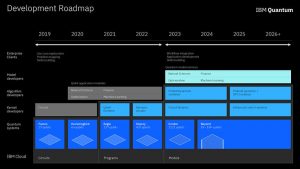
IBM announced its quantum development roadmap, including a massive increase in the speed of quantum applications in 2021 through a 100x speedup of quantum circuits.
According to the company, improvements to quantum software could lead to speedups that make tasks that only recently took users more than three months to accomplish, to be finished in as little as a day, according to Jay Gambetta, IBM Fellow and Vice President, IBM Quantum.
In a blog post, Gambetta reports that the software map follows last year’s ambitious hardware roadmap that the company released in 2020. It’s main goal is to make quantum computers useful and practical for more people.
“Last year, we laid out our quantum hardware and we’re well on track to hit those goals,” writes Gambetta. “But that was only one part of the story: now we have the software (and classical hardware) to make the quantum computers programmable. IBM’s vision is a world where anyone can use a quantum computer to solve a big problem – it’s not just for physicists and mathematicians.”
It’s a sentiment echoed by Ilyas Khan, CEO and founder of Cambridge Quantum Computing (CQC), a company that has partnered closely with IBM on providing quantum solutions.

“IBM and CQC are aligned in the mission to foster the growth of quantum computing over the next decade, both in terms of the quantum capabilities but in collective investment on the overall hybrid and quantum cloud ecosystems,” said Khan. “CQC is excited and thrilled to not only create, but to deploy groundbreaking software on IBM Quantum’s platform such as generating verifiable quantum entropy for seeding unhackable cybersecurity keys, and to collaborate on the evolution of Qiskit and QASM to continue growing a standards-based quantum community.”
Gambetta explains that IBM’s Development Roadmap is designed to provide different developers specifically the tools they need to produce the best circuits, algorithms and models, while maximizing collaboration.
“We are increasing the variety of circuits and the capacity of our systems to run more circuits more quickly, while developing a platform where quantum developers can work seamlessly in the same integrated cloud-based framework.” writes Gambetta. “Workloads with both quantum and classical components will not be constrained by origin or the nature of integration, and the hybrid cloud will allow these workloads to run everywhere that our cloud-native systems run today and in the future. ”
He added that the roadmap expects boost in circuit run capacity.
“This year, we plan to release the Qiskit runtime—an execution environment that increases the capacity to run more circuits at a much faster rate than ever before, and with the capability to store quantum programs so other users can run them as a service,” he writes. “The Qiskit runtime rethinks the classical-quantum workload so that programs will be uploaded and executed on classical hardware located beside quantum hardware, slashing latencies emerging from communication between the user’s computer and the quantum processor.”
Gambetta said the quantum team at IBM has a secret weapon: the open source community.
“Thankfully, this time around we’ll have the help of an open source community’s power and ability to mobilize developers worldwide, plus cloud-native deployment of quantum workloads, in order to break down any potential barriers and to democratize access to this new technology as quickly as possible,” he writes.
Will Zeng, founder, Unitary Fund, an organization that is championing the quantum open source community, said that he’s excited about IBM’s roadmap and how it might help open source developers.
“The Unitary Fund is building a broad, open, and inclusive ecosystem for quantum technologies,” said Zeng. “With IBM’s support, we have backed quantum open source projects, platforms and communities, and we are excited and hopeful that IBM’s developer roadmap will continue to empower developers and encourage adoption of quantum computing.”
Faster, more accessible and more practical quantum computing is the ultimate goal for IBM, according to Gambetta.
“We hope that our roadmap toward this truly frictionless development framework can deliver the best experience with quantum computers in the world for our users, clients, and our quantum computing community,” Gambetta writes. “And we certainly do not plan to take this journey alone. Through continued release of open source software for the community to explore, create, and develop exciting new quantum applications, we will build the quantum ecosystem of tomorrow, together.”


















